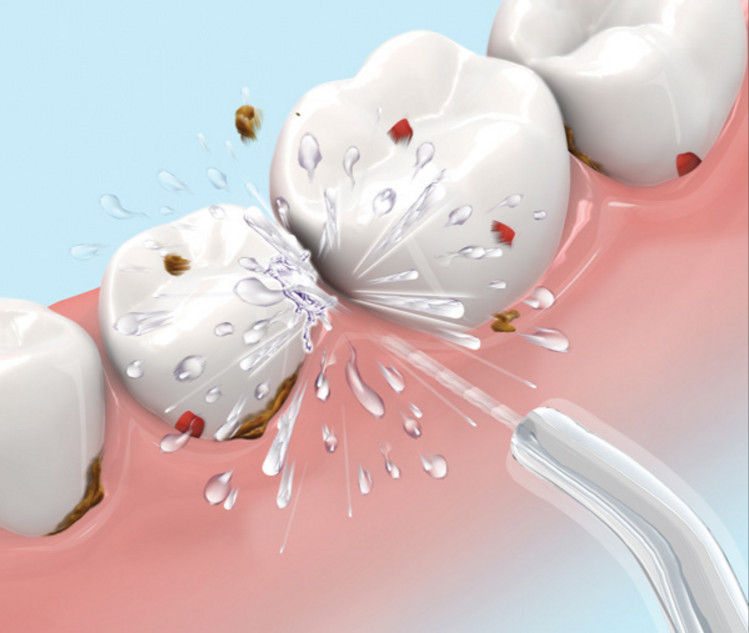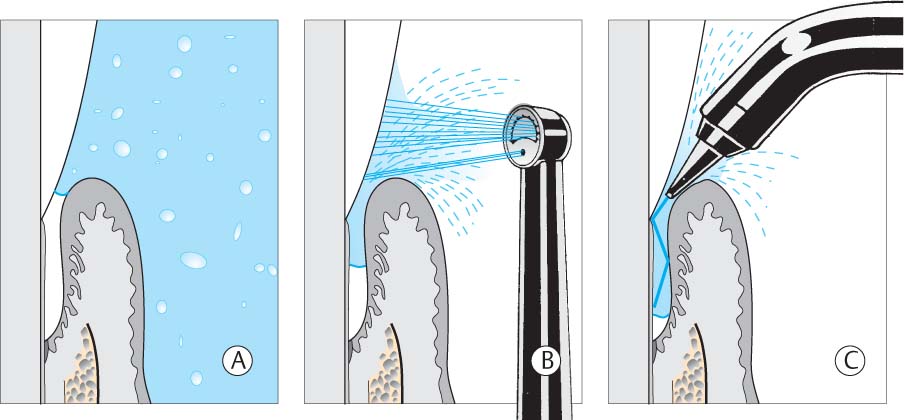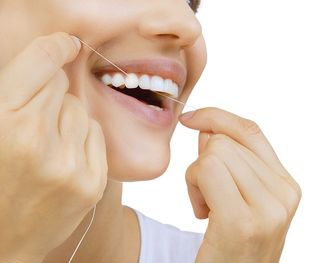
Image credits







History:
During 1960's, Dr. Gerald Moyer was dealing a patient with chronic periodontitis.
Periodontitis is a medical term to coin the severe stage of different gum diseases. It can be in any form or in state.The main problem related to periodontitis is the retained food particles or the plaque. Plaque is the most risk factor for periodontal disease and needs to be controlled or eliminated in a daily basis.
Dentists usually remove the deposits by using a scaler machine or manual scaling. But if patient is not maintaining their own oral hygiene properly. The treatment procedure, a.k.a Scaling/ Oral prophylaxis, will be of no results.
Dr. Gerald was facing that same kind of problem with such patients. He and his patient Mr. John Mattingly, who is an engineer, jointly designed a prototype machine which is called as water flosser today.
Dr. Moyer then trained the patient, suffering due to chronic periodontal problem, with that first machine and let him use it. After 6 months the patient came back with the best results and Dr. Moyer decided to invest in such a machine to help the patients with chronic periodontal problem.
Nearly 60 years it is now a popular product in dentistry and the results of efficacy are showing good numbers to depend upon. Since inception, this product had many names like "oral irrigator", "Dental Cleaning System", "Dental Water Jet", and now it is known as "Water Flosser".
Progress:
1962-1972
The first water flosser was named as the "Octopus" and it came with the 'classic jet tip'. Classic jet tip was introduced in dentistry during 1962, when the non-specific plaque theory was widely accepted.

Different researchers involved themselves to study the efficacy of this product in maintenance of oral health. The initial research was only targeted to see the exact mechanism of action for this device.
They found 1200 pulsations per minute is a key component to clean the inter-dental perio pockets than the continuous stream devices. They have also added that a medium 50 psi pressure to high 90 psi pressure is effective in cleaning the plaques.

Image Credits to WaterPik(R)
Then they indulged themselves in designing the water jet tip. The water jet tip with an angle parallel to the long axis of the tooth is more effective than the tip angle perpendicular to the long axis of the tooth.
This device got so popular during that time that U.S. Army oral surgeons modified this device to use it in cleansing facial wounds during Vietnam war. Orthopedic surgeons also found interest in using such a device to clean the soft tissues from the bone.
Some of the researchers were concerned about the actual efficacy of this product. They were concerned that this device may help the bacteria to penetrate in the soft tissue. A separate study group emerged and performed several investigations, histo-pathological evaluations and clinical studies.
During 1969, Dr. Ralph Lobene came out with a report that 52% of the chronic ginigivitis patients came with the best results after using this device for a year. Only 32% of the patients came up with a good result after brushing twice a day for an year. The patients used water flosser also showed less calculus accumulation than the other group. There was no reports on any effect over hard tissues.
Orthodontists were pretty convinced with the results that they started to study about the bacterial accumulation in their fully banded patients. After 63 days of use, the study showed 80% reduction of aerobic flora and 60% reduction of lactobacillus in a orthodontic patient.

There was a dilemma among the patients about what to buy for their oral health care items. A group of researchers then developed a team to study the patients by dividing them into two groups.
One of the groups will be using the water flosser only for 2 weeks and the other will be brushing twice a day. The group of patients using only water flosser showed less food accumulation in the proximal spaces but they had a good amount of plaques than the other group.
The researchers then started their second phase of study for another 2 weeks with the same group of patients. They have added brushing to the first group of patients. After 2 weeks of study they came up with overwhelming results about the device. But, the device did not fulfill the requirements of a "satisfactory plaque control device" as it was not able to remove plaques when it was used without brushing.
1981
The device was gaining its popularity with some controversies and different results but, it was generating interests among the patients. During 1981, a study came up with a blow about the use of water flosser. A case report presented about a 23 year old girl came up with repetitive episodes of rapid bone loss in her both first molar regions. She claimed that she was using the "Oral irrigator" everyday.
This publication stirred up the confidence of several dentists and there was another group of researchers came up with an idea, to learn about the effect of this device over hard tissues.
The doctors were convinced that the aggressive bone loss was due to the improper use of this device. A second group of doctors came up with another great idea which was the key role to know about the aggressive periodontitis. During 1980's the emphasis from non-specific plaque hypothesis was shifting towards specific plaque hypothesis.

The device was loosing its dignity and the assumption regarding this device, about pushing down microbes deep into the pockets, was gaining negativity.
Cobb et al came up with an idea to provide evidence about this discussions. He selected 12 of his patients with severe periodontitis. These patients presented periodontally weakened teeth with deep, about 6 mm, pocket depth.
He simply used the water flosser on 60 psi load for 8 seconds prior to the extraction for six of his patients and did not used water flosser for the other group.
After collecting the samples the specimen were treated and sent for studying bacterial culture, scanning electron microscopy (SEM) and transmission electron microscopy (TEM).
The evidence showed that the teeth extracted after using the water flosser had reduced microorganisms up to 6mm than the other group.
During 1986, a new area of study evolved that was unexplored till date. Ekale et al studied 2 different angular tips to judge the water flosser efficacy. It showed that 90 degree jet tips are more efficient in penetrating deep into the pockets to clean the area. The study revealed 75% of the deep pocket depths can be cleaned with the 90 degree water flosser tip.
1990
The specific plaque hypothesis studies have shown that presence of certain microorganisms inside oral environment can lead to severe periodontitis even after using any means of oral care products.
The researchers came up with a study that showed regular rinsing with Chlorhexidine, Essential oils, Zinc Sulphate, and acetylsalicylic acid can improve the oral health condition by removing these subgingival pathogens.
A random clinical trial was conducted in three groups of patients. One group was using the water flosser without using any antimicrobial solutions. One group was using only 0.12% Chlorhexidine mouth rinse. The remaining group was given a solutin of 0.06% Chlorhexidine to use with their water flosser.
Only 26% of the patients using 0.12% Chlorhexidine showed good results. But 47% the patients using 0.06% Chlorhexidine solution as irrigation showed a better oral condition.
Studying about this results varying the dilution of the solution a new idea came up with the water flosser. A new tip was designed to introduce the solution into the better depths of a pocket.

The site specifin Pik PocketTM tip was introduced to gain the access into the perio pockets. FDA approved this tip as safe to use and this concluded into another study comparing the water jet tips.
Site specific pik pocket tip showed 90% access in 6mm depth pocket, 64% access in a 7mm depth pocket.
2000
The gradual up-gradation of water flosser was inventing new areas of research along with its modifications. During 2005 a study was conducted to compare manual flossing over water flossing. The patients using water flosser showed a far better result than the patients using manual flossing techniques.

During 2006 a Canadian dentist conducted a study with different approaches to reduce the bio-film on the tooth surface. The using water floss once a day and brushing twice showed the best results among the patients. But the conclusion was relevant that nothing is better than tooth brush in reduction of bio-film from the tooth surface.
2010
This year is recognized as the most effective year for water flosser. Evolution of this product was at its peak and the journey from 1960's was set as a mile stone for this invention.
he recognition for water flosser created the world wide acceptance. Several companies have introduced themselves in this market and this field is growing till date.
Selection of the best Solution for Water flosser.
To achieve different dilution levels from 0.12% Chlorhexidine solution the best results came up is as follows,
0.02% CHX sol = 5 parts of water + 1 part of 0.12% CHX
0.04% CHX sol = 3 parts of water + 1 part of 0.12% CHX
0.06% CHX sol = 1 part of water + 1 part of 0.12% CHX
Selection of the tips
There are different kinds of water flosser tips. According to different manufacturer they are named in various ways. In general the water flosser tips can be categorised as

> Classic jet tip - used for general cleansing
> Orthodontic tip - protects the orthodontic appliances.
> Plaque seeker tips - shows a good result on removing plaques from different prosthesis
> Pik pocket TM - typically used for deep periodontal pockets.
> Toothbrush tips - a water flosser tip along with a tooth brush. (few manufacturer provides this)
Most popular water flossers in India
Oracura OC001
Oracura smart flosser OC001 is a 5x better plaque remover among the water flosser options.
It comes with 3 modes of Soft, Normal and pulse mode varying the need of oral care in Home,Travel, Braces and Bridges.
0.6mm of ultra fine water flow to remove plaques or deposits from deep pockets.
It comes along with Protective case, portable USB charger, and a 150ml capacity water tank.
The company provides 2 standard nozzles and and with a easy nozzle releasing button to replace the tips.
It has auto shut off after 2 minutes of cycle.
MRP is around 3250/- and comes with discount prices varying the seller.
It has a 4.3 ratings over 5.
For more details click here
Oracura smart OC100
Oracura smart flosser OC100 has the same features like OC001 except the water tank. It comes with a 300ml capacity water tank.
MRP is Rs. 3050/-. Available in amazon with a promising discount
For more details click here
Oracura smart OC010
Features are same as the OC100, only the protective case is not added with this product.
For more details click here
Oracura Smart OC002
This is the best package from this company combining all the features and with the most elegant looks incorporated.
Compared to others this has almost same features as OC001, and OC010.
But in this package you can get all different tips that is required for a complete oral care.
It includes
3 standard nozzles
1 Orthodontic tip
1 tongue cleaner tip
and
1 pocket tip
MRP is Rs. 3950/- but available in the amazon with attractive discount price.
Check for more details here.
Oracura OC004
It is the most compact and easy to carry water flosser for travelling.
To check the price on amazon click here
Oracura OC003
The best product available in the market as a table top water flosser for the family.
It has a 600ml capacity water tank, a flosser unit extension from the body with a 1mtr long cord.
It has 10 pressure modes to change according to the need for the family members. The pressure change ranges from 30 psi - 110 psi.
Water pressure flow comes with 1400 pulses per minute with a auto shut off option after 2 minutes cycle.
It comes along with 4 interchangable tips according to need, as
3 standard nozzles
1 Orthodontic tip
1 tongue cleaner tip
and
1 pocket tip
MRP is 3850/-, available in amazon with discount price.
To check click here.
In case of accessories requirement you can visit here for guidance or check in amazon for the availability.
Oracura Pocket tips for OC001, OC010 ,OC100, OC002- click here
Oracura pocket tips for OC003 - click here
Oracura orthodontic tips for OC001, OC010 ,OC100, OC002 - click here
for OC003 Orthodontic tips - click here
Oracura standard tips for OC001 & OC002 - click here
Oracura standar tips for OC003 - click here
Oracura tongue scraper tip for models OC001 &, OC002 - click here.
For more details - click here
In conclusion Modern dentistry is evolving with its own grace. Dental problems are also increasing day to day. Irregular food habits, less time for oral care, professional stress, replacing regular meals with fast foods are the main reasons behind this dental problems. To save your teeth by preserving your precious time it is worthy to use water flossers in a regular basis.
Few other available options in amazon
Presented by Dr. ARKA BHATTACHARYA
Consultant Dental Surgeon, Kolkata
Acknowledgements
Google.com



No comments:
Post a Comment